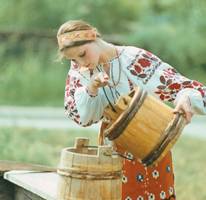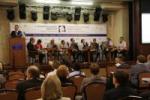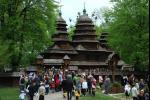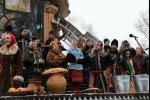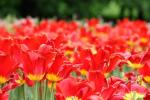- عربي
- Ukraine
- Economy
-
Investment
- Current Investment Trends
- Legal Conditions of Doing Business
- Investment Policy
- Competition
- Setting a Business in Ukraine
- Mergers and Acquisitions
- Taxation
- Import and Export
- Banks and Bank Regulation
- Convertibility and Profits Repatriation
- Currency Regulation
- Protection of Intellectual Property Rights
- Companies
- Travel to Ukraine
- About us
- Useful Sites
- Gallery
- News
Currency rates in UAH
| AED | ||
| BHD | ||
| EGP | ||
| KWD | ||
| LBP | ||
| OMR | ||
| QAR | ||
| SAR | ||
| SYP |
2015-07-06
| Kiev |  |
+32 |
| Donetsk |  |
+28 |
| Dnipropetrovsk |  |
+31 |
| Lviv |  |
+31 |
| Odessa |  |
+27 |
Culture
Ukraine has been developing its own original culture since very early times of its history. There were periods when Ukrainian culture experienced considerable influences of other cultures such as those of Byzantium and of the Vikings (in the medieval times of Kyivan Rus), but basically it preserved its general original quality. The Old Ukrainian language was used as Latin of Eastern Europe for a period of time.
Though oral literature existed in the very early periods of Ukraine's history, written elite literature began to develop from the end of the 10th century. After the adoption of Christianity which gave a big boost for the development of culturein Ukraine. The churches of Kyiv - and their number - caused admiration of foreign travellers visiting the city in the 11th and 12th centuries. The eleventh-century Grand Duke Yarsolav the Wise founded a library which became one of the biggest in Europe, and promoted the institution of schools, including those for girls. In later centuries, literacy was widely spread in Ukraine.
In spite of a turbulent and dramatic history, Ukrainian culture constant was always preserved beginning from the early times of its existence. Book printing began in the country in 16th century and the first establishment of higher learning - the first not only in Ukraine but in the whole of Eastern Europe - Kyiv-Mohyla Academy, sprang up in the early 17th century.
Notwithstanding its colonial status, Ukraine had a wide spectrum of art and literature which entered a phase of stepped-up development in the 18th century. Poetic and prose works written by Taras Shevchenko, the most revered cultural figure of Ukraine, Ivan Kotlyarevsky, Lesya Ukrayinka, Ivan Franko, Mykhaylo Kotsyubynsky and other authors of the nineteenth and twentieth centuries, were a worthy contribution to world literature.
Folk music, and later symphonic and opera music were and are among Ukraine's cultural strengths.
National traditions and rituals
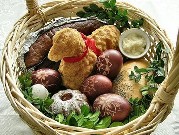
Ukrainian national traditions, customs, and oral folk literature reflect Old Ukrainian pre-Christian, and Christian cultures. The rituals derive from the folk calendar, religious celebrations like Christmas, Easter and Whitsuntide, Ivana Kupala (St.John's Eve), New Year, and the autumn folk festivals dedicated to the end of the agricultural work.
Holidays were celebrated during periods of transition from one type of agricultural activity to another. Easter, for example, is a spring holiday. Spring is a time of ploughing and sowing in the fields for the locals so as to provide Ukraine with food for the upcoming seasons. This is a time of warmth and rebirth after a cold, hungry winter. In pagan times Ukrainians believed that the gods died and were reborn every year. An example of a pagan ritual is the dyeing of eggs.
To the Christian Ascension Day (the 40th day after Easter) Ukrainians added a pre-Christian tradition of going to the field to inspect the progress of the wheat, main food crop of Ukraine.
The Trinity is celebrated on the 50th day after Easter in summer. Traditionally, people decorated their homes with green tree branches and fragrant herbs. Another summer holiday full of magic and ritual is known as Saint Kupala (July 7th). During this day everyone has to be at least immersed in water. This is the last holiday before the harvest.
August 2nd is known as St. Illia Day which marked the beginning of autumn. People say - "Until dinner it's summer, after dinner it's autumn". On the 19th of August known as Saviour Day vegetables, fruit, mushrooms and honey were blessed. Weddings usually took place in the middle of October. A unique feature of Ukrainian Christmas festivities is the Vertep or puppet theatre. Young people would get together; dress as angels, kings, Herod, animals. They walk from house to house singing Koliadky, greeting everyone with the holiday.
Old and modern day literature
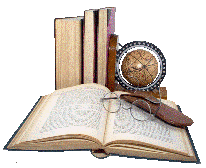
The literature has always been a vital component of Ukraine’s culture. The literary works, originating in the times of Kyivan Rus', are represented by numerous Old Church Slavonic documents. About 1500 manuscripts have been discovered by our days, among them are well-known autobiographies of the first prelates of Rus', Olha and Volodymyr; biographies of the great martyrs Borys and Hlib; the first collection of laws, the Ruska Pravda; historical chronicle Povist' vrem'ianykh lit (Tale of Bygone Years); and Slovo o polku Ihorevim (Lay of the Host of Ihor). The Middle Ages also left a legacy of hundreds of dumy (historical songs), lyrical folk poetry, and tales.
The first printings shops appeared in the sixteenth century and during the next two centuries thirteen printing houses were established in Kyiv, Chernihiv, Lviv, Lutsk, Kremenets, Uman, etc. The first Ukrainian newspaper Gazette de Leopol was first published in 1776.
In the sixteenth and seventeenth centuries, Ukrainian literature experienced a renaissance despite the Polish and Russian countermeasures. Cossack chronicles and hundreds of works written in Ukrainian have come down to us. It was the time of famed Ukrainian philosopher, writer, and educator Hryhory Skovoroda. Ivan Kotliarevsky's Eneyida, where Virgil's Aeneid heroes were turned into Ukrainian Cossaks, introduced a new age of Ukrainian literature.
In 1840, Taras Shevchenko's collection of poetry Kobzar was published which raised Ukrainian literature to world standards. Shevchenko is considered to be one of the major developers of literary language due to his numerous literature works. He was also a renowned fighter for freedom of the Ukrainian people in the nineteenth century.
Also making great contributions to the Ukraine's of the nineteenth century heritage were such writers as Ivan Franko, Lesia Ukrainka, Mykhailo Kotsiubynsky, Ivan Nechui-Levytsky, Pavlo Hrabovsky and many more.
The literature of the twenties century was characterized by two different movements when part of the authors remained in Ukraine and many others fled to form the Diaspora now scattered all over the world. Many writers and patriots - among them Volodymyr Vynnychenko, Pavlo Tychyna, Ostap Vyshnia, Volodymyr Sosiura, Vasyl Stus, Oles Honchar, and Lina Kostenko - tried to express themselves under the totalitarian Soviet regime. At the same time the Ukrainian Diaspora enriched the national literature with such names as Olha Teliha, Ivan Bahriany and Yuri Lypa, who had to write far away from their native land. Independence has made it possible for all of today's readers to access to the Ukrainian literary heritage previously concealed from them.
Currently, the Ukrainian literature is reinventing itself due to the declaration of independence and lifting of the censorship that took place in the Soviet Union. Most contemporary mainstream literary works in the Ukrainian literature lie within the postmodernism dimension.
Yuri Andrukhovych, Serhiy Zhadan, Oksana Zabuzhko, Oleksandr Irvanets, Izdryk, Maria Matios, Ihor Pavlyuk are among the top contemporary published writers to date.
Yuri Andrukhovych is an Ivano-Frankivsk-born Ukrainian prose writer, poet, and essayist. To date, the writer has published five novels, two volumes of essays, four poetry collections, and a cycle of short stories, as well as literary translations from English, German, Polish, and Russian.
Serhiy Zhadan is a Ukrainian poet, novelist, and essayist. Born in Eastern Ukrainian Starobilsk, Zhadan taught Ukrainian and world literature in early 2000s. In 2008 his novel “Anarchy” made it to the short list of the National Bestseller Prize. Critics receive Zhadan’s works as an outstanding mix of individual style and modern literary tendencies. His prose is sometimes referred to as “poetic”, while his free verse is called “prosaic”.
Oksana Zabuzhko is a contemporary Ukrainian poet, writer and essayist. Born in Western Ukraine, Zabuzhko, who holds a doctorate degree in aesthetics, taught Ukrainian literature at the Harvard University and the University of Pittsburgh in 1994. Her controversial bestselling novel “Field Work in Ukrainian Sex” was translated in eight languages. The book focuses on the issues of self-identification, post-colonialism, and feminism. Her book “Let My People Go” won the Best Ukrainian documentary book award in 2006, her work “The Museum of Abandoned Secrets” – Best Ukrainian Book 2010.
The Ukrainian writer Maria Matios is the winner of the “Book of the Year 2004” and of the Taras Shevchenko National Award in 2005 (for her novel “Sweet Darusia”). The author of 12 volumes of poetry and prose is considered to be the most productive modern Ukrainian writer. Her most widely known works include: “Sweet Darusia” (2003-2005), “Nation” (2002-2003) and “The Short Life” (2001). Matios bases her books on her family history that has been preserved by the family through the centuries and goes back to 1790.
Ihor Pavlyuk is a Ukrainian writer and research worker who won the People’s Taras Shevchenko Prize, the Hryhorii Skovoroda prize, the International Nikolai Gogol literary prize “Triumph”. One of his most
outstanding works is the novel “Forbidden Bloom” (2007).
Music
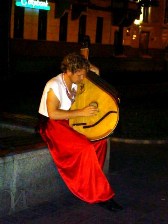
Folk music in Ukraine reflects the gains and traditions of the Kyivan Rus'. These were mainly ritual songs sung acappella. Historical songs (dumy) and kobza-playing appeared as typical Ukrainian folk genres in the sixteenth century. The Hlukhin School of singing and Kyiv-Mohyla Academy was the core of musical education from the seventeenth to early nineteenth century’s. Ukrainian choral music reached its peak owing to the works of Dmytro Bortniansky, Maksym Berezovsky, and Artemi Vedel.
The first Ukrainian opera, Zaporozhets za Dunayem (A Zaporozhzhian Cossack Beyond the Danube), by Semen Hulak-Artemovsky was written in 1863. Ukrainian classical music was dominated by Mykola Lysenko (1842-1912) and in the twentieth its traditions were further augmented by Levko Revutsky, Borys Liatoshynsky, Stanislav Liudkevich, Volodymyr Barvinsky, Kost Dankevych, and Hryhory Maiborada.
Independence has encouraged the development of all musical directions: Ukrainian song is being restored; there are musical genres in popular music: Cossak songs and song poetry, Polissia magic pop, and Kolomiya rap. Numerous new festivals and competitions have sprung up and the most popular are the Tavriya Games. Opera art festivals, international organ and piano music festivals have become a tradition.
Theatre
The roots of the Ukrainian theatre lie in the mythology of the ancient Slavs. There were prince and retinue theatres in Kyivan Rus'. In 1573, the first puppet theatre was founded. In the second half of the eighteenth century, the professional Ukrainian theatre was established.
Les Kurbas is considered to be the founder of the modern Ukrainian theatre. Despite the suppression by the Soviet power of national traditions, Ukrainian theatres continued to develop with the number of theatres and drama troupes constantly increasing. Many Ukrainian producers and actors were recognized all over world. Independence has encouraged the dramatic arts. Private theatres have emerged and held festivals that feature the best acting groups from many countries of Europe, America, and Asia. These are: Mystetske Berezillya ("The Art of Berezillya", Kyiv), Zolotyi Lev (Golden Lion, Lviv), and Serge Lyfar Ballet Competition. New artistic approaches have been expressed by I. Borys, S. Danchenko, S. Moiseyev, and V. Petrov. Producer Roman Viktiuk is now widely known thanks to his work. He is actually making the greatest impact to the world theatre aesthetics at the end of the twentieth century. Among stars of the contemporary Ukrainian stage, there are such names as Bohdan Stupka, Borys Kozak, Fedir Stryhun, Ada Rohovtseva, and Valeriya Zaklunna.
Cinema
The directing career of Oleksandr Dovzhenko was one of the landmarks in twentieth century world cinematography. His works have entered the golden heritage of the Ukrainian and world cinema. In 1958 at the International exhibition in Brussels his film Earth (1930) was recognized as one of the best twelve films of all times and nations.
From the 1960s to the 1990s, the Ukrainian schools of poetic, historical, and documentary films were the focus of attention. Films by Ukrainian directors have enjoyed success at international festivals and contests.
Many awards of international prestige were won by Serhiy Paradzhanov's film, Shadows of Ancestors Forgotten, winning a place among the classics of the Ukrainian cinema (alongside with Babylon XX by Ivan Mykolaichuk, and the Petition Lost by B.Ivchenko). In the 1960s, the film won first prize at the International Cinema Festival in Mar del Plata (Argentine), the Cup of the Festival of Festivals in Rome, award of the British Academy of Film and Television, Gold Prize in Thessalonike (Greece). The film Swan Lake: The Zone (by Paradzhanov and Yury Illienko, 1990) was the first in the history of Ukrainian film to win the grand prix of the Cannes film festival.
News features and documentary films of independence show the pages of the Ukrainian history, culture, national traditions, that were forgotten or hidden before. The best films are widely recognized by international audience. Such films as Fuzhou by Yury Illienko, Asthenic Syndrome by Kira Muratova, and The Voice of Grass by N. Motuzko have gained great popularity at film festivals in Cannes, Rotterdam, and Berlin. The Friend of the Deceased by V. Kryshtofovych has been great success in the prestigious Two Weeks of a Film Director program in Cannes. The Ukrainian film The Derelict was awarded the grand prix at the 36th San Remo Film Festival.
Architecture
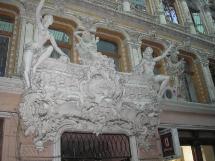
Ukraine's architecture began
developing during the 9th century during the Kievan Rus era. Buildings from
this time period were constructed out of wood and included churches, fortifications
and palaces. Timber was placed in horizontal sections with a hipped roof that
provided a base for further construction. An example of a residential home in
this style is seen in Chernihiv. At around the same time the Byzantine style
began to take root in Kievan Rus. Both architectural styles had an influence on
each other. Byzantine domes were reformed and colours used in decorating became
more Rus.
From the 12th to the 15th century defensive structures such as castles, fortresses and protected monasteries were constructed in populated areas. Decorative patterns can be seen on the massive walls of these buildings in the form of red brick plakhta. Fortified monasteries closely resembled castles as they were carefully adapted to guard against attack.
Between the 16th and 17th centuries a new form of architecture arose in Ukraine that was Renaissance. This is clearly seen in the architecture of Ukraine's Lviv. Renaissance style greatly developed Ukraine's Baroque style. Soon a completely Ukrainian form of Baroque architecture was born. During the 18th century Ukraine's architecture began to feature plastering. Classicism came to the fore at that time and more public buildings and palaces were built. Ukraine's architecture of the late 1800s and early 1900s took on a variety of styles such as modern, neo-classicism, neo-Gothic and Moorish.
Sadly, numerous stunning buildings were destroyed during the communist regime. Despite this many exquisite examples of Ukrainian architecture can be viewed throughout the country.
Painting and sculpture
The mosaics and frescoes of the St. Sophia Cathedral (eleventh-twelfth centuries) and other ornaments of Kyiv churches have been preserved. The surviving paintings of the Kyivan Rus' are, however, not numerous. With the waning of the Middle Ages the Renaissance became the dominant influence on Ukrainian culture, its icon paintings, and later in portrait styles. Gradually, the visual arts began to evoke national sentiments. Classicism and realism in Ukrainian art were greatly influenced by the heritage of the poet and painter Taras Shevchenko. Many Ukrainian artists from the mid-nineteenth through early twentieth centuries devoted their works to the picturesque and poetic nature of their native land (Illya Riepin, I.Aivazovsky, and A.Kuindzhi).
The early twentieth century was marked with an intensive spread of the avant-garde in painting and sculpture. The new movements were evident in the work of V.Yermylov, K.Malevych, O.Bohomazov, and the sculptures of Oleksandr Arkhypenko, who was a pioneer of Cubism. The most famous Ukrainian painters of the twentieth century are well-known: Mykola Boichuk (Monumentalism), Heorhy Narbut (Neobaroque), Tetiana Yablonska, Hryhory Yakutovych, and Mariya Primachenko.
Sand animation in Ukraine
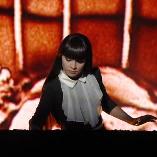
Kseniya Simonova is one of the few artists who perform in sand animation
not only in Ukraine but around the globe. She came into the spotlight in 2009
upon her victory in the Ukrainian installment of the popular talent competition
Ukraine’s Got Talent.
Sand animation is a style of live performance art in which an artist
instantly creates a series of images that change each other in an
animation-like motion using sand as their material of choice. The images are
created by drawing lines and figures in the sand using one’s hands.
Over the two years since her victory at the talent competition Simonova
performed in Austria, China, Germany, India, Italy, Japan, Kazakhstan, Russia,
Netherlands, Norway, Poland, Qatar, Switzerland, United Kingdom, and others.
The Ukrainian artist rehearsed and prepared for performing more than 200
animated sand stories. Notably, Kseniya Simonova was the stage artist during
the 2011 Eurovision show representing Ukraine together with the singer Mika
Newton.
PinchukArtCentre in Kyiv
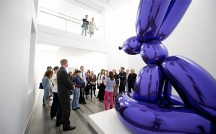 One of the centers of contemporary art PinchukArtCentre opened in Kyiv
on September 16, 2006. The project is the largest private museum in the Eastern
Europe. The venue focuses on bringing to the public most outstanding piece of
modern art. Artists from all over the world exhibit their works at the venue.
One of the centers of contemporary art PinchukArtCentre opened in Kyiv
on September 16, 2006. The project is the largest private museum in the Eastern
Europe. The venue focuses on bringing to the public most outstanding piece of
modern art. Artists from all over the world exhibit their works at the venue.The managers of the center pose the task to combine modern international art with Ukrainian national idea as the challenge for the success of the establishment.
The building of the PinchukArtCentre is located in the very heart of Kyiv and the architecture of it matches the purpose of the venue. The inner design of the center was created by the French architect Philippe Chiambaretta. The six stories of the PinchukArtCentre feature multiple exhibit halls, video lounge, work space, and a café.
The work schedule of PinchukArtCentre is well adjusted to the demands of modern life – the center is open between 12 a.m. and 9 p.m., the entrance to the venue is free, which allows the Kyiv youth to visit the place regularly.
PinchukArtCentre officially represented Ukraine at the Venice Biennale in 2007 and 2009. According to the representatives of PinchukArtCentre as of June 2011 the site was visited by over 1,180 thousand visitors.
Preservation and restoration of historic monuments
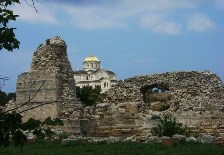
More than 500 cities of Ukraine have a history of more than 900 years old and 4500 villages of Ukraine are more than 300 years old. Historical cities and villages are our national riches.
There are 150,000 monuments of culture, history, archaeology, citybuilding, architecture, palaces and park building art, as well as 300 museums in Ukraine. Seven national historical and cultural preserves have been created. More values are the monuments of Kyivan Rus (IX - XII centuries) epoch - 80 % of the monuments of this period are concentrated on the territory of Ukraine. The most remarkable monuments are the Kyyevo-Pecherska Lavra (Kyivan Cave Monastery), the St. Sophia's Cathedral and the historical centre of Lviv. They have been entered into the List of the World Heritage of UNESCO. Very rich historical and cultural heritage is represented by St.Andrew’s and St.Cyryl’s Church in Kyiv, historical monuments, and the cultural heritage of Zaporizhzhya Cossacks. Also there are monuments about the days of the national liberation struggle of Ukrainian people in 1648 – 1654 and World War II. There are architectural and house-holding museums under open sky in Kyiv, Pereyaslav-Khmelnytsky, Lviv, Uzhgorod, Chernivtsi, Galych, art galleries in Kyiv, Odesa, Feodosiya, Lviv, Kharkiv etc. Tourists are very interested in architectural monuments of various epochs and styles: monuments of defensive architecture - fortresses in Lutsk, Medzhybizh, Kamyanets-Podilsky, Khotyn, Bilgorod-Dnistrovsky, Uzhgorod, Mukacheve; palace complexes in Crimea, in Lviv and Chernigiv regions; monuments of wooden worship and civil architecture in the Carpathians.
Today many old cathedrals and churches are under restoration: the Cathedral of St.Michael's Monastery of the Golden Domes in Kyiv, Uspensky Cathedral in Kyiv-Pecherska Lavra (Monastery of the Caves). There are over 20,000 architectural monuments in Ukraine and the most famous of them are included in the UNESCO World Heritage list. Important events in recent years has been the renewal of the memory of Ukrainian historical figures: the erection of monuments in honor of Princess Olha, Prince Volodymyr the Great, Taras Shevchenko, Mykhailo Hrushevsky, memorials to victims of Stalinist 1930s-1940s repression, and victims of famine of 1930s.
